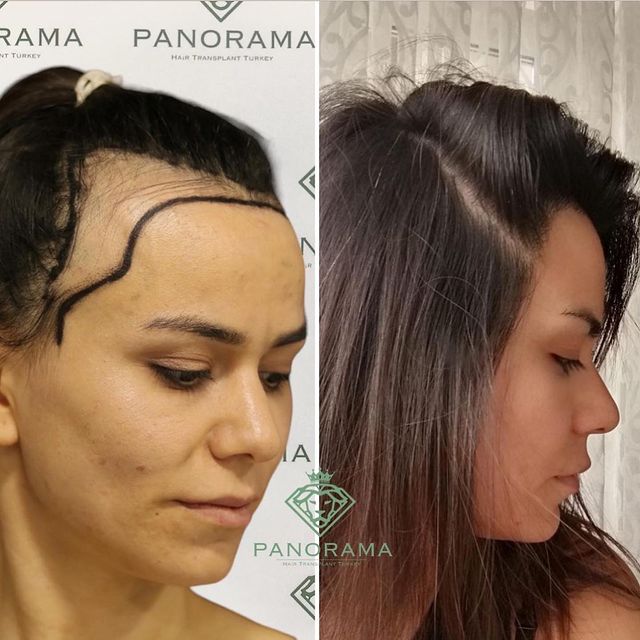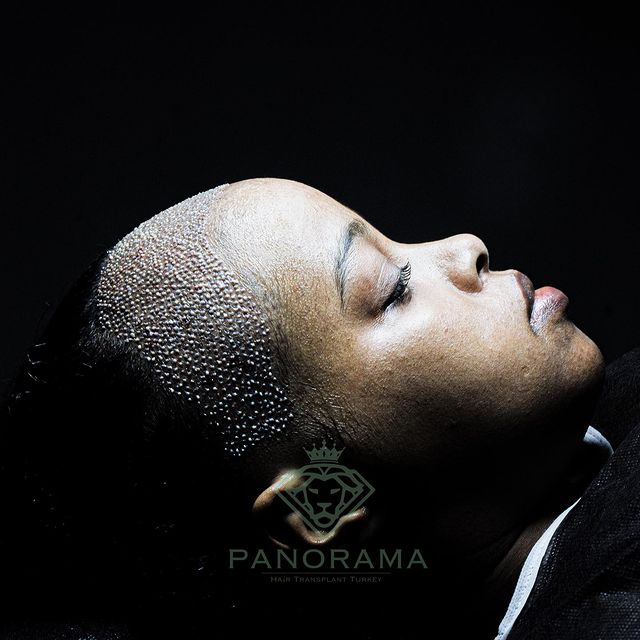Hair transplantation in women is a treatment method for women who suffer from hair loss and want to regrow their hair. Hair loss in women usually occurs for various reasons such as genetic factors, hormonal changes or stress. Hair transplantation aims to address this problem with a permanent solution.
Hair transplantation involves transplanting healthy hair follicles into areas with lost or sparse hair. This is usually done with two main techniques: FUE (Follicular Unit Extraction) and DHI (Direct Hair Implantation). Both techniques aim to collect hair follicles from the donor area and place them in the desired area in a natural way.
 Hair Transplant Process for Women: A Step-by-Step Guide
Hair Transplant Process for Women: A Step-by-Step Guide
Hair transplantation for women is a comprehensive process and consists of several stages. Here is the step-by-step hair transplant process:
Preliminary Consultation
The hair transplantation process begins with a detailed preliminary consultation. At this stage, the causes of hair loss and treatment goals are evaluated. Your doctor will determine the most appropriate treatment method according to the type and intensity of hair loss. In addition, the condition of the donor area and the area to be transplanted is examined.
Treatment Plan and Preparation
After the consultation, an individualized treatment plan is drawn up. This plan includes the techniques to be used and the number of sessions. The scalp is cleaned and disinfected before the procedure. If necessary, local anesthesia is applied to ensure a comfortable experience during the procedure.
Hair Root Harvesting
For hair transplantation, healthy hair follicles must be collected from the donor area. In the FUE technique, the procedure is usually performed with micro-needles as the hair follicles are harvested one by one. In the DHI technique, the hair follicles are prepared with a special device before being placed directly into the transplantation area. This step is carried out carefully and care is taken to preserve the vitality of the hair follicles.
Transplantation of Hair Roots
The collected hair follicles are placed in the desired areas of the scalp. During transplantation, the hair follicles are placed according to a natural growth direction, so that the transplanted hair looks natural and harmonious. This stage ensures direct and effective placement of the hair.
Recovery and Maintenance
After the procedure is completed, there may be slight redness and swelling on the scalp. This usually resolves within a few days. Hair mesotherapy, special care products and regular follow-up appointments help to support the healing process. Your doctor will give you detailed instructions about care and the healing process.
Seeing Results
After hair transplantation, it may take time for hair to grow. Hair loss may occur in the first few weeks, but this is normal. Full results usually appear within a few months. Being patient and following your doctor’s recommendations will help you achieve the best results.
Hair transplantation for women is a treatment method that requires care and attention at every step. The step-by-step process carried out by a specialized doctor ensures successful and satisfactory results.
Hair Transplant Techniques for Women
Hair transplantation for women is performed using a variety of techniques, each of which aims to effectively solve the problem of hair loss. Here are the main techniques used for hair transplantation for women:
- FUE (Follicular Unit Extraction): The FUE technique is a modern method in which individual hair follicles are extracted and placed in the transplantation area. In this technique, hair follicles are collected individually from the donor area using micro-needles. Care is taken to avoid damage to the hair follicles during the procedure. FUE is a minimally invasive method and usually provides a fast healing process and natural appearance.
- DHI (Direct Hair Implantation): In the DHI technique, hair follicles are placed directly into the transplantation area. In this method, hair follicles are placed one by one in the transplantation area using a special device. The DHI technique allows the hair follicles to be placed more precisely and accelerates the healing process. In addition, this method can be effective in achieving natural and natural-looking results.
- PRP (Platelet Rich Plasma) Therapy: PRP is a treatment method used in combination with hair transplantation. Plasma from one’s own blood is injected into the scalp to nourish hair follicles and stimulate hair growth. PRP therapy can increase the effectiveness of hair transplantation and promote faster and healthier hair growth.
- Sapphire Technique: In the sapphire technique, hair follicles are placed with special sapphire-tipped instruments during the transplantation process. These instruments make more precise incisions in the scalp, allowing the hair follicles to settle more smoothly and naturally. The sapphire technique offers less tissue damage and a faster healing process.
- Micro Needling (Microneedling): Microneedling opens micro channels in the scalp with small needles to better nourish the hair follicles and stimulate hair growth. This technique is often used as a supportive treatment before or after hair transplantation.
Hair transplant techniques for women are selected according to individual needs and the type of hair loss. Each technique is designed to solve the problem of hair loss and achieve natural-looking results. A specialized doctor will perform a thorough evaluation to determine the most appropriate method and ensure a successful treatment process.
Suitable Candidates for Hair Transplant in Women
Hair transplantation in women offers an effective solution for people who meet certain conditions. Suitable candidates are usually women who have significant hair loss and want to regrow their hair.
Suitable candidates for hair transplantation are defined by the presence of an area of significant hair loss. This is often caused by genetic factors, hormonal changes or stress. It is important that the areas where candidates experience hair loss are suitable for treatment.
General health is also an important criterion. A healthy body supports healing during the hair transplantation process and reduces the risk of complications. In addition, the hair transplant recipient must have sufficient donor area. The donor area is usually the back and sides of the head, and these areas should have healthy and sufficient hair follicles.
It is also a critical factor that candidates have realistic expectations. Hair transplantation can stop hair loss and stimulate the growth of new hair, but it does not guarantee a completely natural hair density. Therefore, candidates need to set realistic expectations of the process.
Post Hair Transplant Care and Recovery in Women
The care and recovery process after hair transplantation in women is a critical stage for achieving successful results. Proper care after hair transplantation both accelerates the healing process and supports the healthy growth of the transplanted hair.
Firstly, there may be a slight redness, swelling or pain on the scalp immediately after the procedure. These symptoms are usually temporary and subside within a few days. Your doctor may recommend prescription medications or creams to keep such side effects to a minimum.
During the healing process after hair transplantation, it is important to keep the scalp clean and dry. You should be careful not to wet the scalp for the first few days. Special shampoos or cleaning products recommended by your doctor should be used. Paying attention to the cleanliness of the scalp reduces the risk of infection and accelerates healing.
After hair transplantation, you should be careful about physical activities. Avoiding intense exercise and excessive movements is important for the transplanted hair follicles to settle. You should also avoid exposure to direct sunlight and wear a hat that protects the hair.
Benefits of Hair Transplantation for Women
Hair transplantation in women aims to solve the problem of hair loss permanently and offers many advantages.
First of all, hair transplantation provides natural-looking results. The procedure performed with expert techniques ensures that the transplanted hair follicles grow in harmony with the existing hair. Thus, the appearance obtained is quite natural.
Hair transplantation offers a permanent solution. Since the transplanted hair follicles are genetically resistant to hair loss, they provide healthy hair growth in the long term. This provides a long-term solution to the problem of hair loss.
Increased self-confidence is also an important benefit. Hair loss can be a psychological burden for women. Hair transplantation provides fuller and healthier hair, boosting self-confidence and making you feel better about yourself.
Modern hair transplantation techniques offer a fast recovery process. Procedures performed using minimally invasive methods usually provide a comfortable recovery process. There is usually mild discomfort after the procedure, but you can quickly return to daily activities.
Hair transplantation can be customized according to individual needs. Since the causes of hair loss and the hair structure of each woman are different, the treatment process is planned according to individual characteristics. This is important to achieve the best results.
 Hair Transplant Results in Women: What to Expect
Hair Transplant Results in Women: What to Expect
Hair transplantation in women provides effective results when performed correctly. However, it is important to understand what kind of results to expect after the procedure. Here is an overview of what to expect after a hair transplant:
Initial Results: In the first few days after hair transplantation, there may be mild redness, swelling or pain on the scalp. These symptoms are usually temporary and subside within a few days. In the first week, the process of settling of the transplanted hair follicles begins and crusting may be seen on the scalp during this period.
Growth of New Hair: It is normal for the transplanted hair to fall out in the first few weeks. This is part of the transition of the hair follicles into a new growth cycle. This shedding is usually temporary and new hair will start to grow back within a few months. Patience is important in this process.
Visual Improvement: After about three to six months, you will see new hair starting to grow and blending in with the existing hair. The hair may be thin at first, but over time it thickens and takes on a natural appearance. It can usually take 9 to 12 months for the full results to appear.
Quality of Results: The quality of hair transplant results depends on the technique applied and the hair structure of the person. Hair transplants performed with modern techniques usually provide natural-looking and permanent results. However, each individual’s hair structure and healing process is different, so the results may vary from person to person.
Long Term Results: In the long term after hair transplantation, the results obtained are permanent as the transplanted hair follicles are genetically resistant to hair loss. Regular care and a healthy lifestyle help to maintain the health and appearance of the new hair.
After hair transplantation in women, natural, permanent and satisfactory results are usually achieved. However, the healing process requires patience and attention. Following your doctor’s recommendations and attending regular follow-up appointments will help you achieve the best results.
Frequently Asked Questions
When can I start seeing results after a hair transplant?
In the first few weeks after hair transplantation, the transplanted hair may fall out. It usually takes three to six months for new hair to start growing. Full results usually take 9 to 12 months. During this time, you can expect your hair to thicken and look natural.
Which side effects may occur after hair transplantation?
Common side effects after hair transplantation include mild redness, swelling and pain. These symptoms are usually temporary and subside within a few days. There may also be scaling and itching of the scalp, but this is usually part of a natural healing process.
Is hair transplantation permanent?
Hair transplantation provides a permanent solution because the transplanted hair follicles are genetically resistant to hair loss. However, a person’s overall health and lifestyle can affect the long-term health of the hair. Regular care and healthy living habits help to maintain the health of the transplanted hair.

 Hair Transplant Process for Women: A Step-by-Step Guide
Hair Transplant Process for Women: A Step-by-Step Guide
 Hair Transplant Results in Women: What to Expect
Hair Transplant Results in Women: What to Expect